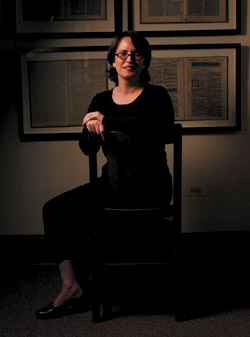 |
|
|
Divinity School professor Amy Hollywood takes a front seat in the debate over suffering’s role in religious life. Sometimes Divinity School professor Amy Hollywood, who studies medieval Christianity, forgets how gruesome her subject matter can be. When presenting a paper on devotion to Christ’s side wound during the Middle Ages, she says during a recent conversation in her fourth-floor Swift Hall office, “I’ll look up and notice my audience turning green.”
In a text that Hollywood, AM’86, PhD’91, researched for that paper, the 13th-century Umbrian mystic Angela of Foligno relates a vision. In it Christ calls on her to drink and be purified by the blood flowing from his side, pierced by a Roman soldier during the Crucifixion. The mystic also describes physically entering Christ’s wound and becoming one with her savior—grotesque images to modern audiences, yes, but Angela’s tale, Hollywood points out, is among a host of medieval devotional texts and illustrations about the saving power of Christ’s wounds. More intriguing than the graphic images, for her, is that Angela’s The Book of the Experience of the Truly Faithful portrays a woman’s spiritual experiences. Female mystics such as Angela played a crucial role in the great debates of the Middle Ages, Hollywood says, as Christians puzzled over “the best way to live in this world. “In the 12th, 13th, 14th, and 15th centuries,” she explains, “there was no agreement about what constitutes the best form of religious life.” The ideal way to follow Christ is, of course, still up for debate, but the consequences of dissent aren’t always as dire. Christians who wrote and spoke out on such matters exposed themselves to possible condemnation for heresy and even burning at the stake. Yet certain women—believed to have special God-given graces including visions, prophesies, and physical experiences like the stigmata and other forms of bodily suffering—were not only permitted but, in fact, called upon to speak and write about their encounters. How those female medieval mystics enriched the religious discussion is what interests Hollywood, a 40-ish woman who looks hip in jeans. On a filing cabinet behind her sits a Jesus action figure still in its packaging. “When we pull the pious veneer off this stuff, we see how weird and fascinating it is. And then,” she pauses, “we see how radical these women are.” Women’s mystical experiences, Hollywood says, were particularly salient for the question, “Should we make the Passion of Christ—the act of taking on suffering—central to religious life?” (As the recent controversy over Mel Gibson’s violent The Passion of the Christ demonstrates, this question persists today.) “Christians were supposed to focus on the redemption,” she says, “yet the Passion is irresistible for people in the Middle Ages.” In a time of plague and short, difficult lives, they were “obsessed with death and mourning.” For Angela of Foligno, an affluent Italian laywoman whose visions led her to embrace poverty, meditating on Christ’s great physical sacrifice was pivotal to the 30 transformational steps detailed in The Book of the Experience of the Truly Faithful: “And I was so disposed myself on account of his love that I wished that all my limbs might suffer a death unlike his Passion, that is, a more vile death,” she wrote. Another of Hollywood’s papers describes Margaret Ebner, a sickly 14th-century German mystic who lived in a Dominican monastery. In her Revelations Ebner recounted weeks of head- and toothaches so agonizing she wished for death. Yet the pain, Ebner believed, was God’s way of granting her desire to participate fully in Christ’s suffering. For Hollywood, a former Catholic schoolgirl from Annapolis, Maryland, who now describes herself as “not religious at all,” such writings provide an intriguing angle on the present-day fascination with—and ambivalence toward—violent and traumatic images. “The ways in which we in the U.S. think ethically about violence, suffering, and trauma,” she proposes, “are deeply indebted to and linked by the Christian tradition in ways we don’t recognize.” As medieval Christians meditated during Holy Week on Christ’s very human and agonizing Passion, read mystical texts, and contemplated paintings and missals that depicted a blood-drenched Christ, violence and pain became accepted parts of living a religious life. “Contemplation of suffering was understood to be transforming of the self,” Hollywood says. And to take on suffering willingly, as Ebner did and Angela longed to, was a redemptive act. When people view images of extreme suffering
now, she says, “we feel compassion, and through compassion
for suffering, one participates in suffering.” Such empathy,
she points out, signifies self-transformation; during the Middle
Ages that feeling was sought out as a step on the path toward salvation.
“But our present-day notion of compassion lacks that redemptive
framework,” she says. “It’s been snipped off the
top for most people,” so the images of suffering also make
them feel uneasy. By studying medieval mystics, Hollywood, who’s
currently writing about memory, mourning, and Christian mysticism,
hopes to link the present with the past and, perhaps, explain the
ambivalence.—Sharla A. Stewart |
|
phone: 773/702-2163 | fax: 773/702-8836 | uchicago-magazine@uchicago.edu

 Investigations
Investigations